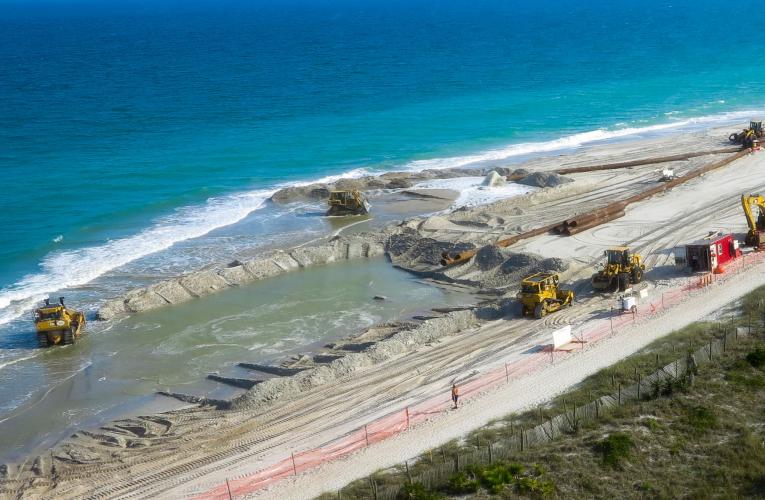NOTE TO EDITORS: Dylan McNamara is available for additional comment at (910) 962-2588 or mcnamarad@uncw.edu; Martin Smith is available at marsmith@duke.edu; Brad Murray is available at (919) 681-5069 or abmurray@duke.edu.
DURHAM, N.C. -- The value of many oceanfront properties on the East Coast could drop dramatically if Congress were to suddenly end federal beach nourishment subsidies, a new study by researchers at three universities finds.
In beach nourishment, new sand, often dredged from nearby inlets or the offshore sea floor, is added to an eroding beach to widen it and help prevent future erosion.
“The expectation that the federal government will continue to provide subsidies for erosion-control measures has significantly inflated property values in many coastal communities,” said Dylan E. McNamara, associate professor of physics and physical oceanography at the University of North Carolina Wilmington. “If these subsidies were suddenly removed, our model suggests values could experience a rapid and dramatic adjustment downward.”
“Values could erode by as much as 17 percent in towns with high property values and almost 34 percent in towns with low property values,” said Martin D. Smith, professor of environmental economics at Duke University. “This would be analogous to the bursting of a bubble.”
Researchers from the UNCW, Duke and The Ohio State University published their findings today in the open-access peer-reviewed journal PLOS One.
Alarming as the new numbers are, the researchers caution that their findings should not be viewed as the last word on the issue nor should they be interpreted as a policy recommendation to continue the federal subsidies.
“This analysis doesn’t include all the factors that affect coastal property values, but the erosion-related factors we examine are important ones, and the model is grounded in hard empirical data,” said A. Brad Murray, professor of earth and ocean sciences at Duke. “We expect our model’s predictions to be close to what could actually happen.”
To assess the effect federal beach nourishment subsidies have on property values -- and what the impact might be if subsidies abruptly ended -- the researchers incorporated historic and current resale values of oceanfront homes on nourished beaches and un-nourished beaches in North Carolina into a specially designed stochastic dynamic optimization model. They also incorporated three types of erosion that commonly affect beach width and stability in the state: chronic background erosion caused by rising sea levels or differences in alongshore sediment transport; sporadic erosion of nourished beaches from storms; and temporary increases in erosion that can occur as beaches adjust to recent nourishment.
By analyzing the data, the model clearly showed that “if the beach is being protected from erosion by nourishment, a large part of the value of the house comes from that protection,” said Sathya Gopalakrishnan, assistant professor of agricultural, environmental and development economics at Ohio State.
Though the model is based on North Carolina data, its findings are broadly applicable, said Gopalakrishnan. “It lines up well with the range of property values and environmental parameters found on most other East Coast sandy shorelines with the exception of a few urban areas like Atlantic City,” she said.
Between 1995 and 2002, the federal government spent $787 million on beach nourishment and has historically subsidized two-thirds of the total nourishment costs incurred by coastal communities. In recent years, however, some legislators have called for deep cuts in federal spending on nourishment or ending the subsidies outright.
“It’s a complicated issue, especially at a time when rising sea levels and increased storminess are projected.” said Smith. “No one wants to foot the bill for unnecessary subsidies. But if you don’t pay for defensive nourishment and end up having to pay more in disaster relief, it doesn’t make economic sense.”
Said McNamara, “Our results suggest that if nourishment isn’t a long-term strategy the federal government wants to use to manage eroding coastlines, a gradual removal is more likely to smooth the transition to more climate-resilient coastal communities.”
Funding for the study came from the National Science Foundation (grants # 0951802 and 0952120).
###
CITATION: “Climate Adaptation and Policy-Induced Inflation of Coastal Property Value,” Dylan E. McNamara, Sathya Gopalakrishnan, Martin D. Smith and A. Brad Murray; PLOS One, Mar. 25, 2015. DOI: 10.1371/journal.pone.0121278.
© 2015 Duke Office of News & Communications
615 Chapel Drive, Box 90563, Durham, NC 27708-0563
(919) 684-2823; After-hours phone (for reporters on deadline): (919) 812-6603
